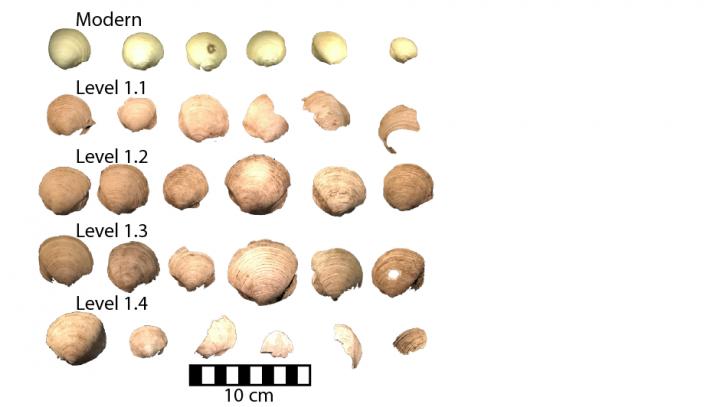Analysis of 2,500-year-old fossilized clam shells reveals ancient Caribbean cooking methods

Credit: Philip Staudigel, Ph.D.
MIAMI–A new study by scientists at the University of Miami (UM) Rosenstiel School of Marine and Atmospheric Science, University of Miami (UM) College of Arts and Sciences, and Valencia College analyzed the fossilised remains of clams to reconstruct the cooking techniques of the early inhabitants of Puerto Rico. The results showed that Puerto Ricans over 2,500 years ago were partial to roasting rather than boiling their food as a soup.
The research team used a new chemical technique to examine fossilised clam shells collected from an archaeological site in Cabo Rojo, Puerto Rico to identify the exact cooking temperatures at which the clams were cooked. They found that cooking temperatures were around 200oC.
“The only way we have of knowing how our ancestors cooked is to study what they left behind,” said the study’s lead author Philip Staudigel, who conducted the analysis as a graduate student at the UM Rosenstiel School and is now a postdoctoral researcher at Cardiff University. “Here, we demonstrated that a relatively new technique can be used to learn what temperature they cooked at, which is one key detail of the cooking process.”
The study, published in the journal Science Advances, sheds new light on the cultural practices of the first communities to arrive on the island of Puerto Rico, and also provides circumstantial evidence that ceramic pottery technology was not widespread during this period of history-likely the only way in which clams could have been boiled.
The fossilized shells, dating back to around 700 BC, were cleaned and turned into a powder that was analyzed to determine its mineralogy, as well as the abundance of specific chemical bonds in the sample that were dependent upon heating of the shell.
When certain minerals are heated, the bonds between atoms in the mineral can rearrange themselves, which can then be measured in the lab. The amount of rearrangement is proportional to the temperature the mineral is heated.
This technique, known as clumped isotope geochemistry, is often used to determine the temperature an organism formed. For this study, it was used to reconstruct the temperature at which the clams were cooked.
The abundance of bonds in the powdered fossils was then compared to clams cooked at known temperatures, as well as uncooked modern clams collected from a nearby beach.
Results showed that the majority of clams were heated to temperatures greater than 100°C – the boiling point of water – but not greater than 200°C. The results also revealed a disparity between the cooking temperature of different clams, which the researchers believe could be associated with a roasting technique in which the clams are heated from below, meaning the ones at the bottom were heated more than the ones at the top.
The pre-Arawak population of Puerto Rico were the first inhabitants of the island , arriving sometime before 3000 BC from central or South America. They existed primarily from fishing and hunting near the mangrove swamps and coastal areas where they had settled.
“Much of peoples’ identity draws upon on where they came from, one of the most profound expressions of this is in cooking,” said Staudigel. “The clams from the archaeological site appeared to be most similar to clams that had been roasted.”
###
The study, titled “Boiled or roasted? Bivalve cooking methods of early Puerto Ricans elucidated using clumped isotopes,” was published on November 27, 2019 in the journal Science Advances. The study’s authors include Philip Staudigel from Cardiff University; Peter Swart and Ali Pourmand from the UM Rosenstiel School; Carmen Laguer-Díaz from Valencia College and William Pestle from the UM Department of Anthropology. The study was funded in part by a National Science Foundation grant to Peter Swart.
About the University of Miami’s Rosenstiel School
The University of Miami is one of the largest private research institutions in the southeastern United States. The University’s mission is to provide quality education, attract and retain outstanding students, support the faculty and their research, and build an endowment for University initiatives. Founded in the 1940’s, the Rosenstiel School of Marine & Atmospheric Science has grown into one of the world’s premier marine and atmospheric research institutions. Offering dynamic interdisciplinary academics, the Rosenstiel School is dedicated to helping communities to better understand the planet, participating in the establishment of environmental policies, and aiding in the improvement of society and quality of life. For more information, visit: http://www.
Media Contact
Diana Udel
[email protected]
305-421-4704




